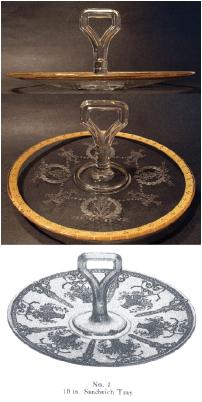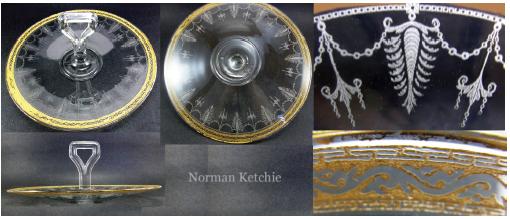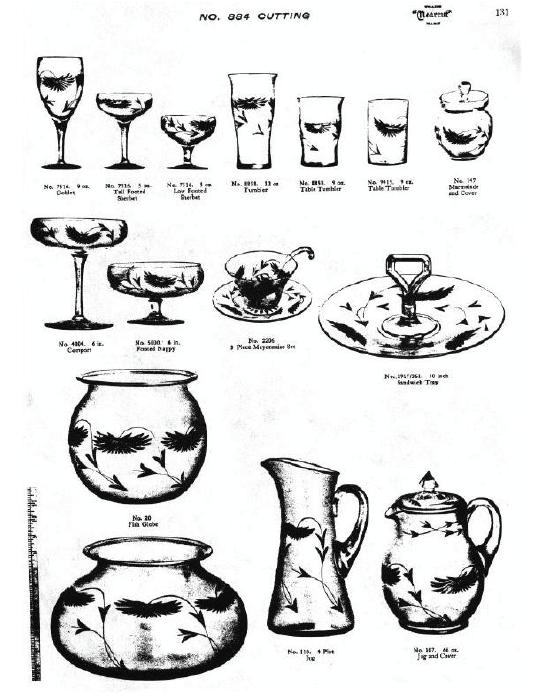Is it the No. 2 or the No. 1917
Vee handle Cambridge sandwich plate?
by Inez Austin
Issue No. 436 - March 2010
Recently I managed to buy a No. 2 or a 1917 Vee handle
Cambridge center handle server (CHS). I have been actively
searching for both of these CHS for more than ten years.
 Both are listed as being 10 inches in diameter. Imagine my
surprise when my new CHS with the Wedgewood etch turned
out to be 11-1/8 inches in diameter. It is 7-1/8 inches tall,
and has a 2-3/8 inch wide handle and 3¼ inch wide collar.
Both are listed as being 10 inches in diameter. Imagine my
surprise when my new CHS with the Wedgewood etch turned
out to be 11-1/8 inches in diameter. It is 7-1/8 inches tall,
and has a 2-3/8 inch wide handle and 3¼ inch wide collar.
The Wedgewood etch was introduced circa 1921 and discontinued before 1927 and is in Cambridge Catalog No. 10 (1921). The Wedgewood etch is made up of etch 625 circa 1920 combined with etch 408 circa 1913. The No. 2 server shown on page 93 of The Cambridge Glass Co. Cambridge, Ohio, A Reprint Of Parts Of Old Company Catalogues by Mary, Lyle and Lynn Welker (aka Welker 1) intrigued me. I knew it was not the same as the later square top Vee handle servers but the catalog page just wasn't distinct enough to prove it to myself without an example.
The Vee handle No. 2 CHS may have entered production as early as 1916 or as late as 1920. The 1916 date is arbitrary and chosen because the Dresden etch was introduced circa 1913 and competitors like Westmoreland and Heisey were selling loop handle sandwich trays in 1916. I am not mentioning the late American Brilliant servers here because of the difference in form, but rather the ones we think of as Depression Era, even though they were introduced many years earlier.
The No. 2 CHS is the oldest. It appears to have been replaced by the 1917 CHS around 1921. Then around 1927 the Vee handle CHS becomes a 140, 160 or 168. The 140, 160 and 168 CHS have a 2¼ wide handle with very rounded edges. These later CHS have a flat to slightly conical collar that is 2-5/8 wide with a slender double optic. There is a ring on the stem of the handle and a ring or thin pancake of glass underneath the plate and plate diameter ranges from 8½ to 10-3/8 inches. Examples of these servers can be seen as early as the 1927 catalog.
In Welker 1 on page 93 a CHS is shown with a Dresden etch and is
identified as a No. 2. According to searches done on the Cambridge
website, this etch may have been in use as early as 1913 but was
discontinued in 1927. So next look at the catalog page from
1921 shown at the end of this article. It contains a 1917 CHS shown with
 an 884 cutting. Then look at the CHS with the 702 etch (picture
compliments of Norman Ketchie). The 702 etch is thought to
have been introduced about 1925 and discontinued by 1930, as
is the outside band of this etch which is when found alone a 700.
So Norman's server is not a No. 2 or a number 1917 because the
handle has changed. It is a 168. We know that the handle previously
seen on the No. 2 and 1917 CHS is not shown in the 1927-29
catalog. It is a 168 that is on page 1 of that catalog (Spring 1927).
an 884 cutting. Then look at the CHS with the 702 etch (picture
compliments of Norman Ketchie). The 702 etch is thought to
have been introduced about 1925 and discontinued by 1930, as
is the outside band of this etch which is when found alone a 700.
So Norman's server is not a No. 2 or a number 1917 because the
handle has changed. It is a 168. We know that the handle previously
seen on the No. 2 and 1917 CHS is not shown in the 1927-29
catalog. It is a 168 that is on page 1 of that catalog (Spring 1927).
So now I have found a Cambridge 2 or 1917 CHS with an early etch and a stem that is round from the collar until half way up the stem where that section ends in little arches and continues as a six-sided stem that becomes the handle. That lower stem design element resembles Heisey's 1184 server. The Heisey 1184 has a stem with a ring but no collar and is usually crystal. It was introduced in about 1915 as part of their Yeoman line and remained in production until at least 1930. The diameter of the 1184 CHS was 10-1/4 to 10-3/8 inches. So this was a design used by a competitor in the right time frame.
My Cambridge CHS is larger than the documented No. 2 and 1917 server. It has a larger plate in a style made popular by Tiffin, the #15179 introduced in 1924. Chicken and egg here. These companies copied each other in order to keep market share. In conclusion, I think my server is a No. 2 circa 1920-22 and that it was available in two diameters 10 inch and the 11-inch.

